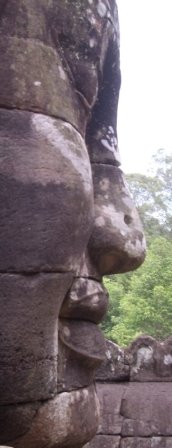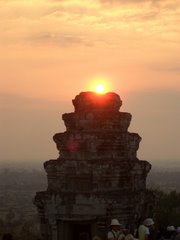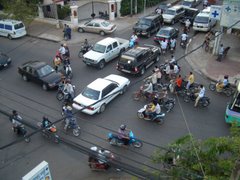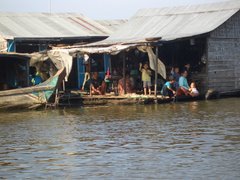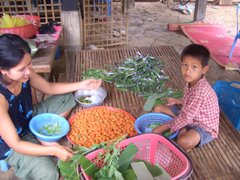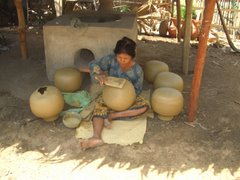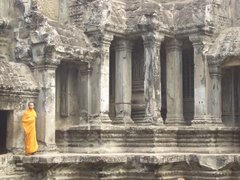Monday, July 30, 2007
A Small Explosion
Just on Saturday I was questioning with Lizzy about how fragile the peace is in Cambodia. After being here for awhile, if you're keen to it, you learn what happens behind the scenes of politics and daily life. The somewhat placid bustling pace of street vendors, moto-dops, half-naked toddlers and ubiquitous honking of horns masks a government that seems to keep things under control.
Most everything looks and seems okay. There are political parties - the CPP is the ruling party with Hun Sen as the Prime Minister, and Funcinpec as its main rival. Then at a distance there is the Sam Rainsy Party and now the new Human Rights Party. There is the usual and typical bickering that reverberates between back and forth between parties. But in recent decades, this is a country that is used to settling political squabbles with violence. Only recently have they had democratic elections and still learning about what that really means, I think.
When the Vietnamese pulled out in 1989 there was a void of leadership and government. The UN came in with UNTAC and troops to keep the peace until there were "democratic" elections in a free Cambodia in 1993. Open fighting in the street aside, an uneasy decision was rendered which put co-prime ministers from CPP and Funcinpec in power. For the next four years it was a very shaky power-sharing agreement between Hun Sen and Prince Rannaridh. But that changed in 1997.
On July 5 and 6 a very swift shift happened when outright armed conflict plagued Phnom Penh once again. The more or less private armies of the two parties skirmished in various parts of the capital city and in the end, Hun Sen became the sole Prime Minister as he is today. According to an article in the Phnom Penh Post, a number of soldiers loyal to the Funcinpec party were later dug up with hands tied behind their backs and single bullets to their heads. Never has there been a thought given to prosecution of those responsible. Some say it was a coup d'etat manufactured by one side; others say that CPP was only defending itself from a reverse coup attempt. Who knows.
The more I'm here, the more I read and the more conversations I have, I begin to learn more of the detail of Cambodia's history that's not easily offered up. The ruling party has the privilege of the spoils - the position of power to control the rich natural resources of the country. It sickens me to realize that so few people enjoy these resources, and yet I equally realize that peace is worth the price that is being borne by the people.
But one must understand the context from which this country springs. People have been exhausted by decades of civil war, genocide and factional fighting, which has been eased by the ways of politics today. So much better than it was and yet so much has been yielded by a populace hungry for peace.
For the casual tourist, the obvious Khmer history is within easy reach. Visitors here are typically guilt-fully shocked at their own ignorance of the atrocities committed at the Killing Fields or S-21 (Tuol Sleng Prison) where nearly 17,000 lost their lives. Or at the news that 500,000 tons of American bombs actually accelerated the Khmer Rouge's ascent to its horrific power. Difficult questions surge forth: "Why did this happen? Why did I not know about this?"
But there is even more to the story than can be easily accessed, even when one is willing to ask the painful questions about what actually happened.
What I have found is that most Khmer do not like to talk about the years and events under the Khmer Rouge. I remember a conversation with three colleagues several months ago where it was revealed that one man's father had been executed by the Khmer Rouge. As his chin nearly grazed his chest I sensitively asked the follow on of 'do you know what happened?' Three eternal seconds ticked by when the voice of another colleague came to the rescue, "We don't like to talk about those kinds of memories." All of us swallowed hard and grasped for some rare air to move on from the delicate subject. I learned something important that evening.
Cambodia is on the verge of the long-awaited and long-delayed trials of the Khmer Rouge. Two million people died during three and three quarter years of their reign. Many were executed, still more died from starvation and slave labor. The number is not even exact, but it was too many, many times over. But for almost 30 years the guilty have mostly gone free. Only Duch, the infamous prison warden of S-21, has been incarcerated since 1999. It's as if the entire KR guilt is laid upon his shoulders, but there were those who directed his actions. We'll see what justice awaits Duch and other old Khmer Rouge leaders, at least those whom are still alive.
So, as a Western visitor in this exotic country, much lies below the surface of tourism and ancient monuments. Still, I feel safe in this place and worry not about what might happen. The struggle for this country is not with me, but with them. "Safe" coup d'etats seem to happen in this region of the world, such as has happened many times in Thailand. My concern is for the people of this country who need its leaders to find a vein of compassion matched with a backbone to fight rampant corruption that sucks the blood of the economy.
Today I read in the Cambodia Daily that three fertilizer bombs, small five-gallon bucket versions of the Oklahoma City truck bomb, had been placed at the base of the Cambodian-Vietnamese Friendship Monument and one had partially detonated. The blast we heard was a controlled explosion of the other two.
And life goes on.
Friday, July 20, 2007
The big green can
I strained my eyes toward the end of the street and began to notice a couple of official vehicles with their emergency lights flashing. Then the majorettes and flag bearers, and finally the band. I could have been in the middle of Pensacola, Pittsburgh, perhaps even Poughkeepsie – but not Phnom Penh. It was a complete Western-outfitted marching band like they’d come straight from the heartland of America.
And then there were floats. Three of them to be exact. The front and rear floats had what looked like huge green cans of Raid insect spray, each about 10 feet tall. I thought, “Hmmm, I guess Raid is sponsoring this parade - how odd.” The middle float had a number of children clad in lime green raid tee shirts and a crowned queen – I suppose she was the Raid Queen of Cambodia. A colossal honor for a young Cambodian girl, I suppose.
But then after the floats came hundreds of children, during the middle of a school day no less, all clad in Raid lime green t’s. Then a few hundred more, followed by a few hundred more. It was unreal. Something big was up.
So I asked my waitress what was going on (actually I just pointed and gestured, using a few pidgin English words to try and communicate with a non-English speaker) and she simply said one word: dengue.
Dengue is a word that strikes fear into the hearts of families with young Khmer children because if left untreated - or poorly treated – it can be deadly. Otherwise known as “break-bone” fever, dengue is transmitted by mosquitoes, similar to malaria, but there is no vaccine against it. There are several forms of dengue, but the most serious form is hemorrhagic dengue. One of my fellow volunteers came down with this form of the disease and had to go to Bangkok for treatment.
So, like malaria, people of the west rarely hear about diseases that ravage children. Several hundred have died here in Cambodia this year, with tens of thousands contracting it this year alone. It is at epidemic proportions this year and it seems to recur every five years or so in SE Asia. With proper medical attention the mortality rate should be very, very low. Not so in Cambodia where the health care system is abysmal – so much so that if any of our volunteers get really sick they get on a plane and head for Bangkok, about an hour away from Phnom Penh.
The availability and quality of medical treatment here is directly related to the inhumane and torturous years of the Khmer Rouge. Democratic Kampuchea may have only lasted less than four years from April 1975 to January 1979, but the utter decimation of civil society rendered nearly all institutions essentially null, including healthcare. Because the Khmer Rouge rejected anything Western, all doctors and medical personnel either were forced to flee the country or were killed. The same fate was met by all formally educated Cambodians who were thought to be polluted by Western thought. Pol Pot wanted Democratic Kampuchea to be rebuilt on an extreme communist platform, Mao Tse Tung style, and to devolve the country into a pre-industrial agrarian society. Two million people lost their lives in this failed communist experiment – nearly one fourth of all Cambodians. (Finally, nearly 30 years later, it appears the trials of Khmer Rouge leaders are actually going to come off.)
So these kids in green shirts were marching to create awareness amongst Khmer families. Buying a can of Raid and spraying it in one's home to kill mosquitoes is one method. Having the government provide mosquito control would be another, but they seem to be too busy with other things. An epidemic is underway, but no action, no acknowledgement of a problem since November 2006 when it started, nothing. Dr. Beat Richner, an outspoken doctor, has been referring to this (and other ignored diseases) as the “passive genocide of children”.
Nearly 20% of Cambodian children don’t reach their 18th birthday. They suffer from a toxic range of threats that children in Western or developed countries simply don’t face, not in large numbers at least. Personally, I was shocked at the huge outcry of support for the young English child, Madeleine, who was abducted in Portugal recently. She is just one of a number of Western poster children who symbolize the high value we place on a Western child’s life. But what about the two to three million children that die each year from preventable diseases such as malaria? Where is the public outcry and outrage over that?
It starts with awareness, and it continues with action. If you'd like to help, one small act you can do that has impact is to support the mosquito net program sponsored by the Cambodia Daily, the local Phnom Penh newspaper. Each $5 contributed buys a mosquito net that provides protection for three family members and will be distributed for free to the most in need Cambodians. Although dengue is the current major threat, malaria is still Cambodia’s most deadly disease. Click here if you’d like to find out how to contribute. 100% of the money goes directly toward buying mosquito nets.
And don't worry about me - I take mosquito borne illnesses seriously. The DEET people are doing very well off of me for these six months.
Wednesday, July 11, 2007
Now THIS is news!
I arrived in

I was a bit nervous doing this in front of 30 other people, but all were close friends and relatives. Many of them were expecting us to get engaged, but all were surprised by the occasion. What was absolutely wonderful was that we have it all on film, thanks to many cameras that were present. You can click here to see some of the pictures. You’ll be able to figure out the proposal – it’s toward the middle of the photo album, just after a series of 8 photos of Lizzy and I standing outside the restaurant having a conversation.
When I was at home in May for
Now, how to do the deed?! I thought long and hard about it and settled on Lizzy’s birthday party with everyone present, at the same small, lovely Italian restaurant where we had our first date. Very poetic.
I designed a “special birthday crossword puzzle” and inserted the printed copy in a $2 crossword magazine and wrapped it up. The funny clues all added up to the proposal words. I thought this would be a good way to honor Lizzy’s dad as well, since he loved to do crosswords and she would sometimes join in with him. And the guests at the party jumped right in to help with the puzzle’s clues. Then Lizzy read the completed answers in no particular order and then everyone knew what was going on.
So that’s how it happened. We’re thrilled and I hope you are too.
My trip here is short and I’m returning to
Sunday, July 1, 2007
Water, water everywhere
Tens of thousands of people live this way and everything has been adapted to a waterborne way of life. Door to door sellers of produce, household goods, clothing, charcoal, ice – everything floats directly to your door.
Children attend school in floating barges and play football on the roofs of their schools in fenced in areas. Churches, stores, work areas, repair shops all float. There are two reasons. First, these people make their living from the water, mostly as fishers. Secondly, they are largely Vietnamese and are landless, so this is one of few alternatives. And above all, a floating village makes complete sense when you realize the water table fluctuates by as much as ten meters.
The Tonle Sap Lake floods annually and expands beyond its normal 1,300 square kilometer borders to nearly nine times its size. At the height of the flooding in August, brought on by the combination of the monsoon and the snowmelt of the Himalayas delivered by the Mekong River, 60% of Cambodia’s land mass is covered with water. And it is around this swollen lake that a miracle occurs: little fingerlings grow up to be adult fish because they find refuge from predators in the shallow flooded forest areas.
Tonle Sap is perhaps Cambodia’s richest natural asset. It is the second most biodiverse natural freshwater body in the world, home to nearly 400 aquatic species. Annually, nearly 340 million tons of fish are harvested from its waters, serving as the livelihood and nutritional backbone of the Cambodian people.
Tyler, Katie and I got a good up close view of life on the water during our trip last Wednesday when we crossed the northern tip of the Tonle Sap and cruised down the Sangker River on the way to Battambang. This was the second time I’d done the cruise which is conducted on a non-US Coast Guard approved boat. Ignorantly charitable, the safest thing about it was that it had no life preservers. And the ultra hard wooden seats made the journey anything but comfortable. This boat dredged up images and stories of the many boating disasters that we often hear about coming from SE Asia.
Safety and comfort aside, it was an experience. The first remarkable thing happened in the first hour. The man directly across from me was hit in the back by a largish, two foot long catfish that jumped into our boat. It caused quite a commotion but eventually the crew tossed it back into the water so it could live to fight another day.
We cruised along the Sangker River and passed through floating villages which appeared about every five kilometers. The boat did double duty as a water taxi by uploading and off-loading locals who paddled out in small canoes to board, many with old rice sacks serving as luggage. We stopped halfway, about four hours into the trip, to have lunch on a floating dock. Little did the rest of the westerners on the boat realize there were still four hours to go!
Amazingly, the Lonely Planet Guide to Cambodia lists the trip as 3-5 hours, but longer in the dry season. Well, the water was way up this time and it still took 8 hours. Of course, that did include the 30 minutes or so we were stranded while the crew finally figured out we were out of gas. No problem, just scurry up the bank to buy a five gallon can of petrol from a farmer and we were on the way again. The Cambodians are terribly practical and resourceful people.
It’s been really fun sharing this experience with Tyler and Katie. Both of them exclaim how wonderful this country is, even with its quirks and inconveniences. They really understand why I enjoy it so much and what I mean now when I say it is a different pace of life entirely.
On Saturday, Tyler and Katie bumped into their tuk-tuk driver, Moul, who had taken them around Angkor Wat on the Tuesday before. Amazing! 25o kilometers away and the same guy turns up on our street visiting his family who live the next block down from me. We invited him to join us for dinner that night, as well as Eddie and Marie (Indonesian and French, respectively), our neighbors from across the hall. So we had quite an international gathering with differing degrees of understanding one other. And this was the first time I have cooked Khmer food for a Khmer person - I think it was also the first time Moul had had an American cook for him!
So now we’re back in Phnom Penh after having visited Siem Reap and Angkor Wat temples for two days, then Battambang for two days. The bus rides on Mon and Fri were 6 hours each and the boat ride Wed was 8 hours, so it can be a wearing experience. Each day of travel, however, is part of the experience.
I’ve uploaded several pics on the web from the floating village to share with you. Perhaps you’ll come here one day and see for yourself.



